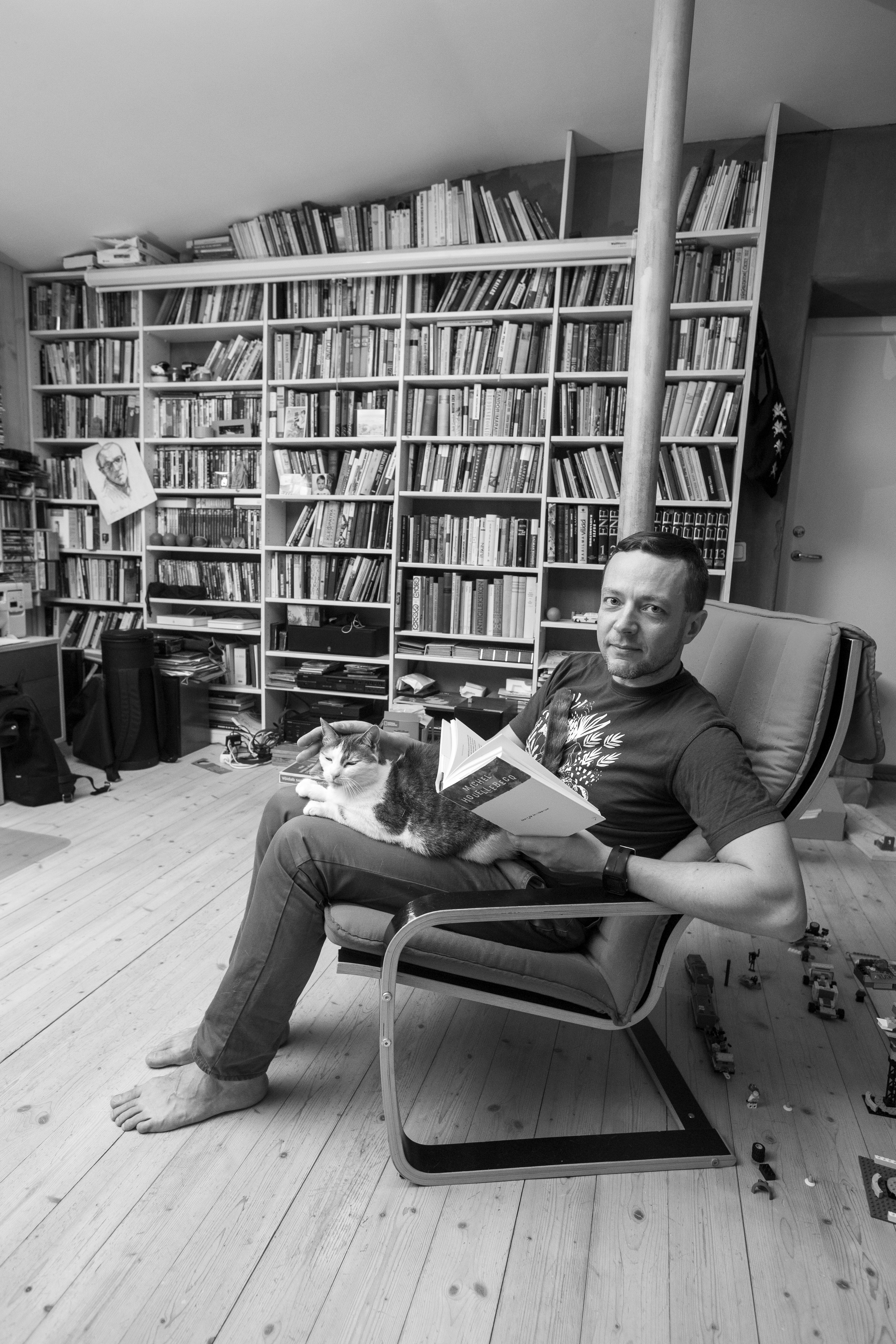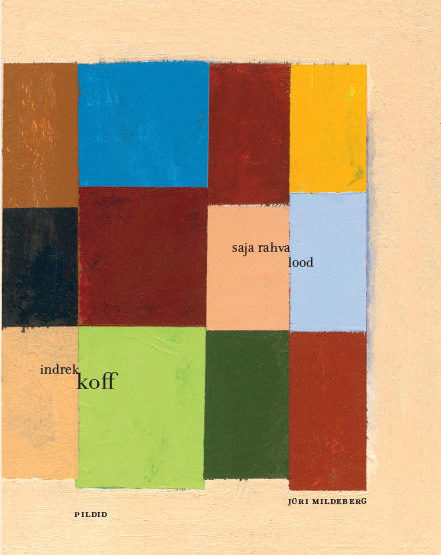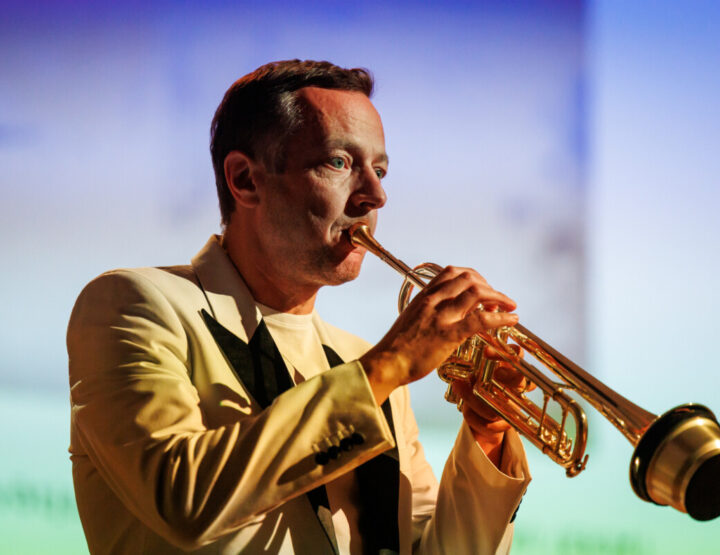Indrek Koff (1975) is one of the most fascinating Estonian authors of the last decade. His writing stands out for its experimentation, the author’s talent for finding intriguing genre opportunities, and his methodical accomplishment of them. Koff can certainly be regarded as a poet, a children’s author, and a translator, but a noteworthy part of his writing shifts between different genres.
Koff first embarked on his literary journey as a translator in the early 2000s. He has translated into Estonian an impressive amount of primarily French-language prose and philosophy: perhaps his most popular translated work in Estonia is Michel Houellebecq’s The Elementary Particles. Koff started on his own writing much later, and thus his lyric poetry debut, Vana Laul (An Old Song, 2006), stands out for its exceptional maturity. In the book, Koff applied, for the first time, his now recurring method of binding individual poetic texts to a particular motif or technique. Koff’s fame soared with his book Eestluse elujõust (On the Energy of Estonian Essence, 2010). Strictly speaking, the work does not contain a single one of Koff’s own words, but is composed of commonplace Estonian sayings and expressions. The author collected these everyday sayings, compiled them into a “hysterical treatise”, and ended up creating something unexpectedly scintillating. Koff continued his literary experiments in 2012 with the book Asjaõigusest (On the Law of Estate), which he produced in collaboration with the writer Jan Kaus and “Raido Mürk”, by all assumptions a fictional character. Mürk (Estonian for “poison”) is a misanthrope who lives on the fringes of the capital, drinks expensive wine, and catches flies in his teeth. No one has ever captured him on film. In 2016, after writing a string of successful children’s books, Koff made a return to experimental literature, simultaneously releasing two unusual works with clearly different constructions: Saja rahva lood (Stories of a Hundred Nations) and Poeem (Poem). These two books provide more than enough reason to probe Koff’s approach and method in greater detail.
Estonian Literary Magazine: One could say that with your new books, the poetry collection Poem and the short-prose collection Stories of a Hundred Nations, you have moved forward in your own particular, experimental method, subjecting the individual texts to a thematic perspective or formulaic technique. Poem’s title could be seen as misleading, but only partly, since each of the collection’s individual texts addresses the very same topic: the ridiculousness and tribulations of being a writer. How and why did you arrive at this topic, i.e. writing about literature?
Indrek Koff: I have to disappoint you: I honestly don’t know how I arrived at the topic, just like I don’t have the slightest clue how I ever arrive at any of my topics. My books (or at least every book’s initial concept, its launching point) tend to arise on their own. The case with Poem is simple, in a way. I live rather deep in the world of writers: I myself write, translate, and verbally convey the written word on stage. I’ve blended with writing: it’s become my “natural habitat”. However, it’s all gone somehow unintentionally, and even against my intentions. In truth, I’m extremely happy that I haven’t drowned in the written world for good – that I come into contact with real life in addition to books, and that I encounter people from entirely different walks of life who have entirely different joys and woes. Generally, poems in which the poet writes about writing poetry tend to annoy me. And now, it turns out that I’ve fallen into the same trap myself, and on top of that, without limiting myself to lone texts, but writing a whole book of it at once… In my own eyes, I’m excused by the fact that in Poem I don’t bring up any personal or imagined character’s convictions. Instead, I simply try to create a kind of space inhabited by the gazes of many eyes and the thoughts of many minds. A space that is by no means exhaustive, closed, or complete, but rather one where movement can continue until it inevitably ceases due to the the laws of physics.
ELM: While Poem might still be viewed as a traditional poetry collection, Stories of a Hundred Nations is difficult to define by genre. Perhaps it is short prose? In that case, one could immediately ask: what kind of short prose? I tend to see your own clear signature in it. You take a literary motif or a method of wording something – in this case, a fairy-tale summary or an introduction to a fairy tale – and start playing it out in every conceivable way. By that logic, Stories of a Hundred Nations is a sequel to your 2010 book On the Energy of Estonian Essence, in which you played with sayings that circulate through the Estonian population. What is it about focusing on a definite motif or a literary method that fascinates you? Why is nudging the limits of genre or ducking between them so important to you?
IK: If I may, then I’d answer with the same words: I don’t know. But I realize I should try to expand a little on that. To start with, I’d like to make clear that I don’t see myself as a revolutionary who is trying to make the world order teeter by stretching the limits of a genre. It’d be extremely naïve to believe that I’m capable of discovering something completely new, and have furthermore accomplished it in my art. No, of course I don’t harbor any such illusions But I have started to feel that thinking one topic at a time as I do, and the “comprehensive” view that has somehow inadvertently become my method both derive from peculiarities of my mental makeup. The same approach has been used in foreign-language literature, and there are quite a few similar works that I’ve enjoyed thoroughly. A couple of years ago, I was given Padgett Powell’s novel-like work The Interrogative Mood: A Novel?, which is composed exclusively of questions. I liked it a lot, above all, of course, because the author’s daring work didn’t remain merely that, but instead rose to the level of a work of art: the experiment had borne fruit, just as intended.
Psycho- and other types of analysts could naturally offer other explanations: ranging from a father figure (or what have you) to a subconscious fear of established genres. I truly have thought, for example, that I would never be able to write a genuine novel. I simply couldn’t manage. The poems that I sometimes, rarely, produce individually (i.e. not as parts of a greater whole from the very beginning) aren’t all that good when viewed as classical poems. I’ve given consideration to writing short stories, but haven’t had the courage or the time to undertake any yet. Et cetera. When a new thought pops into my mind and I notice that once again it wants to take textual shape as some unusual form that is difficult to define by genre, then I’d like to believe it simply had to manifest in that way. But no doubt that “fear” and a hundred other explanations exist and are valid somewhere, even if just faintly. You never know.
ELM: In your books, readers come across quite a lot of existential (self-)irony, the modern man’s sour gaze, social nerve. You’ve quoted Muriel Barbery, whose work The Elegance of the Hedgehog is also available in Estonian thanks to your translation: “We are animals subject to the cold determinism of physical phenomena.” A similar attitude can be found in your works: sometimes they’re worded very playfully, and even cheerfully, and other times more thoughtfully and even melancholically. Since you started out as a translator, have you considered the degree to which your works and mindset have been influenced by the writers you’ve translated (such as Michel Houellebecq)? Or do your influences tend to come foremost from Estonian literature?
IK: Now here, I’m going to have some trouble answering. I’m not much of an interpreter as a reader, a translator, or a writer; rather, I always function almost completely intuitively. On occasion, when there’s no other option (i.e. when I have to give a talk or answer questions, such as right now), I manage to distance from myself a little, and then some kind of an idea or something akin to an analysis might filter through; but that happens rarely and, to tell the truth, I’m not sure I like it. Essentially, I’m a typical representative of a deeply pessimistic world view, due to which I have an affinity for such authors as Cioran and Houellebecq (whose books do, however, contain a strange, backwards optimism). But on the other hand, I’m a romantic. I can sometimes even drift towards sentimentality (and then, my editors have to hold me back with all their might, as they did quite successfully with Poem and Stories of a Hundred Nations). I have an incredible weakness for the works of several Jewish writers, and some inexplicable force draws me towards Portugal and its culture. Unfortunately, though, I can’t comment on whether or how much all of that has influenced my writing. I tend to believe that it’s the literary experts’ job to notice and analyze those influences: they’re much better prepared for it, and they do it better.
I could, however, certainly name a few translated works that have had a strong influence on me as a reader, ones that have clung to me and just won’t seem to let go. Claude Lévi-Strauss’ Sad Tropics enthralled me and continues to enthrall me with its clarity of thought, broad reach, and superbly precise expression. Emotionally, I have been captivated for years by Eric-Emmanuel Schmitt’s Oscar and the Lady in Pink and Emmanuel Carrère’s The Adversary, both very heavy, but nevertheless hopeful stories. Michel Houellebecq’s The Elementary Particles and The Map and Territory have not only had a deep impact on me, but on the greater part of Estonian society. I accomplished one of my biggest dreams when I had the opportunity to serve Emmanuel Bove’s My Friends to Estonian readers: a book that I had been carrying around with me for about fifteen years.
ELM: The artist Jüri Mildeberg’s paintings play an important role in both of your new books. What techniques of Mildeberg’s art fascinate you, and why? Do you treat the pictures as a part of the whole, and feel that they can no longer be removed from the complete work, i.e. when translating?
IK: I’m extremely happy that my writing inspired Mildeberg, and that a dialogue between text and image developed as a result. Jüri’s visual world has always enchanted me, both in children’s books and at art exhibitions. When my good friend Piret Raud started hinting that Jüri and I should collaborate, I believe she initially had a children’s book in mind. However, I haven’t come up with that kind of children’s book yet. Instead, there arose those strange texts that I sensed might have something in common with Jüri’s peculiar world. And, what do you know – they did.
As for translations, I don’t believe that text and illustration are inseparable, necessarily. It can easily be the case that a text fits nicely in another cultural space in some way (or can at least be approachable for the reader), but the illustrations just won’t do; tradition or, perhaps, trends decide a great deal. And similarly, it might happen that a foreign publisher is interested in a book for its visual qualities, but that interest dissolves after becoming acquainted with the text, for some reason. Although I’d like with all my heart and soul to believe that Jüri and I have made The Perfect Book, bitter experience tells me that our complete unit might not work as well everywhere. And that, as a matter of fact, is also interesting.
ELM: Another feature of your books is the theatricality nestled in them. On the Energy of Estonian Essence was recently made into a radio drama, and it has also been performed on stage: you’ve read it together with actors and musicians. Do you intentionally inject theatricality into your texts, or does it simply surface somehow? How important is a writer’s performance in his or her work, the delivery of the writing, in your opinion?
IK: When writing, I usually don’t think about what exactly it is I’m writing at the moment. I allow the pen to run across the paper (yes, I do write with a good old-fashioned fountain pen), confident that whatever is produced will be clear later. Still, I do have a tendency to write in a way that the text reads aloud well. It’s possible that the roots lie in my love of theater, which truly has always been a fascination. I relish direct speech in writing and translation, and have always tried to work “speakability” into my texts, to some extent (something that generally can’t be conveyed in writing, but can at least be accentuated). When writing for children, I also always aim for the text to be alive; for it to at least have some parts that seem like a child’s thought process and sound like a child’s speech.
I elbowed my way onstage with my very first book: the actors Lee Merila and Kutt Kommel and I performed An Old Song several times, and it felt like it was a success. As of today, I’ve performed for audiences quite a lot, and have even learned to enjoy interacting with the audience. And, sometimes, I’ve gotten the impression that the sympathy is mutual. I don’t believe that all writers should read their writing aloud: not every text is suited for it, and not all people are born performers. But if it turns out well, or even average, then you can find out a lot of interesting aspects of the text: kinks appear (if they exist, and they usually do), the author discovers details or entire passages that seemed fantastic while they were being written, but which scream for reworking upon being read aloud, and even the audience’s reactions can direct attention to both the text’s weaknesses and its strong suits. What’s most important is the work that precedes reading it aloud: this forces you to thoroughly and attentively work through your writing, and gives you an opportunity to adjust, polish, and mold it into something better and stronger.
ELM: You’ve written quite a lot for children. One could say that you’ve written even more books for children than for adults. What is best or simpler to address through children’s literature? Does children’s literature allow you to use any frames of mind or standpoints that are not available when writing for adults?
IK: Writing for children makes it easier to stay sane and survive, to hold onto optimism and hope. I think I already mentioned that I’m rather pessimistic by nature. Children help to boost my mood. One of the few things you can’t especially use when writing for children is irony, and refraining from it reminds you that there are other ways of seeing the world. Writing children’s books brings out the brighter side of me, and not, by the way, because I think that one should bake kids a happiness-soaked pie and serve it to them with a mellow, comical sauce. Not at all. Kids can see straight through that garbage; they’re well aware of when they’re being underestimated. They’re often much more interesting and, actually, even more intelligent than adults. There have been periods in my life when I just can’t stand adults (such as when I more or less synchronously wrote the children’s books Home and Ten Little Butterflies). I’ve felt at times that I don’t understand adults, and vice versa, but some kind of common language has always seemed possible with children. I’ve often wondered: “Where on Earth do those smart, open-minded, and exciting people whom I see at schools and kindergartens disappear to? Why does their number only diminish as the years go by? Does life really wear them down so severely?
ELM: Which of your children’s books has been the greatest success so far, and why? Or can that even be asked? Are all of them equally dear to you?
IK: I can’t answer that. Still, there is one rule: the newest is the dearest to you for a short while. It’s the latest one of your works, to which you’ve dedicated yourself with your whole heart and soul. The farther a book recedes in time, the more mistakes you notice. But on the other hand, every book has mistakes, just as there are things that you believe you’ve pulled off pretty well. So, overall, one might say that they’re all dear.
ELM: We’ve translated a selection of texts from Stories of a Hundred Nations for this issue of Estonian Literary Magazine. What Estonian authors or works would you personally recommend for translation?
IK: First and foremost, the ones that appeal to translators: they are the people, to whom we owe a debt of gratitude for their missionary work that results in most foreign-language translations of Estonian literature. If a translator is able to work on a book that touches him or her – one with which the translator can identify – then we can hope that the translation will turn out to be a good one, a text that can speak to readers.
I’d also like to note that there probably aren’t a lot of works about which one can make the general and abstract remark: “This is worth translating.” What comes into play first of all is the question of translatability (i.e. how deeply the text is rooted in its cultural context and time, where and to what extent it draws upon the author’s language, and whether there is any hope in achieving an even slightly similar effect in other languages), as well as the factor of the other culture (i.e. whether the topic speaks to its audience, whether the manner of treatment is fresh and thought-provoking in the culture, and whether it’s at all acceptable in the eyes of the audience, or even of the literary market – because, alas, it is always about the market). Andrus Kivirähk’s The Man Who Spoke Snakish(1) has turned out to be highly popular in France, but how will it do in other cultural spaces? I suppose it’s a Pandora’s box from which questions never end, questions to which clear answers are nowhere to be found.
Despite what I just said, I’ll venture to name a few authors and works that I’m quite certain are worth spreading as widely as possible. One Estonian writer who, I believe, is here to stay, and is luckily already being translated, is Andrei Ivanov. His masterpiece, Harbin Moths, deserves to be translated most of all, though it’s still biding its time. Another author who has likewise been translated, but certainly not enough, is Aino Pervik: children in countries around the world should have the opportunity to read her newest books, as well as her earlier ones, such as Arabella, the Pirate’s Daughter and Old Mother Kunks. A few other personal favorites that might possibly resonate in a more universal plane include Ene Mihkelson’s Plague Grave, Peeter Sauter’s Baby Blue, and fs’ 2004. Oh, there are more and more and more living authors I could list, and there are additionally the timeless classics who are still read and cherished in Estonia. hy shouldn’t they be loved by a foreign audience, too? The first names that come to mind are Eno Raud, Mati Unt, and Kalev Kesküla. I don’t know whether Madis Kõiv is translatable, but one can always try. Oskar Luts, without a doubt. In short, there’s no end in sight to the work available to translators and publishers.
(1) Title translated by Christopher Moseley, and published in English by Grove Atlantic (2016).




